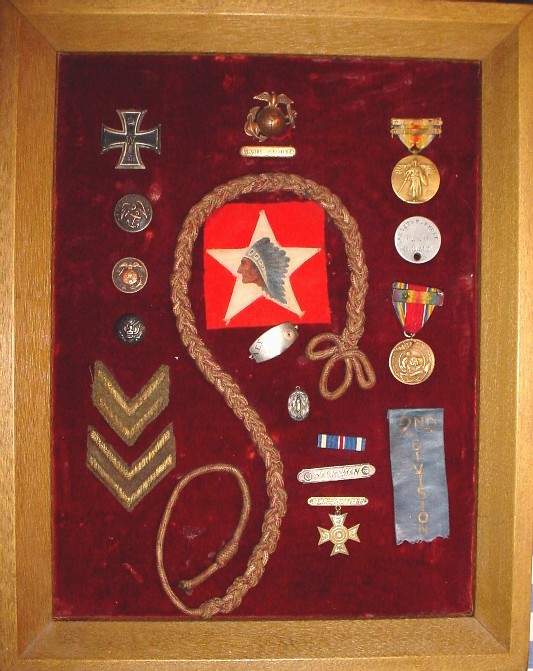A.K. Frost's Military Service Memorabilia

Special Thanks:
Helen Hoke assembled this display of artifacts from Dad's service in the
Marines in WW1. Frank Frost has recently passed them to me, Tom Frost. David Frost
(Victor's son) has kindly agreed to display these pages on this website.
Individual items on the display can be seen in greater detail, with whatever explanation I can furnish at the moment, by clicking on the links below.
Some medals are not included here. For example, Dad's Purple Heart - which was presented to him some 50 years after it was earned - and other items are either lost or their whereabouts is unknown at this time. As we go forward, pictures of those items that we can locate will be added.
A little background:
Arthur Karl Frost, with his older brother David Hans, was enlisted into the
Marines on June 3, 1918, at Paris Island (as they spelled it at that time).
Assigned to the 66th Rifle Company, 1st Battalion, 5th Regiment, 4th Brigade
(Marines) of the 2nd Division of the American Expeditionary Force, he was in
combat in France by Aug 27, 1918, against the elite German troops who were
spearheading their offensive. A month before he and his brother arrived in
France, the feats of the 4th Brigade had electrified the world by stopping the
German offensive cold at Belleau Wood, just 30 miles from Paris. This was the
first major engagement by the American forces in WW1, and it was the first
reversal for the German juggernaut in a long time, occurring just as millions
of people were fleeing Paris, believing that its fall was imminent. The
American forces had not been held in high regard by either the Allies or the
enemy before that.
When Karl and Hans joined the 4th Brigade in combat, then, "The Marine
Brigade" had just become world famous and it continued on as the fist of
the Allied punch. Between June 3rd and Nov 18, the Marine Corps established
its legend. By first stopping the Germans cold, then reversing the tide, and
finally putting the Germans to rout. They did not do it alone, of course, but
every time the attack faltered, the Marines were thrown in the line to get it
moving again, and they never failed to do so. The casualties suffered by the
4th Brigade were horrendous. Although Karl and Hans were both injured (Karl,
"slightly", at St. Mihiel on Sep 15, and Hans, more seriously - he
was in the hospital for nearly a year - at Meuse-Argonne on the day before the
Armistice was signed), both survived the war.
After the Armistice, Karl marched across France, through Belgium and
Luxembourg, and into northern Germany to the town of Wolfenacker for duty with
the Army of Occupation. He was Honorably Discharged on Aug 13, 1919. Hans
remained in the Army hospital in New York for several more months before
returning home.
I find it interesting that what we know of Karl's wartime service, we know only
through public military records. Apparently, he spoke of his military service
in only the briefest way to his children, even the returning veterans of WW2.
This display then, although the ribbons are tattered and the medals are
tarnished, is about as much of a story as we are likely to hear of a young
Nebraska farm boy who went to Europe and fought in some of the most brutal
warfare of modern times, in "The Great War for Civilization" (as it
says on the Victory Medal).
- Background of the now-legendary 2nd Division emblem.
- Military honor issued by the French to the 4th Brigade.
- In honor of victory in The Great War.
- Front and back of "Dog Tag".
- Detail view of this medal.
- The significance of this ribbon is unknown.
- Detail view and explanation.
- Overseas Service and Wound Chevrons.
- Partial explanation.
Eagle, Globe, and Anchor Emblem
- The United States Marine Corps hat device.
- Description.
- Actual uniform.